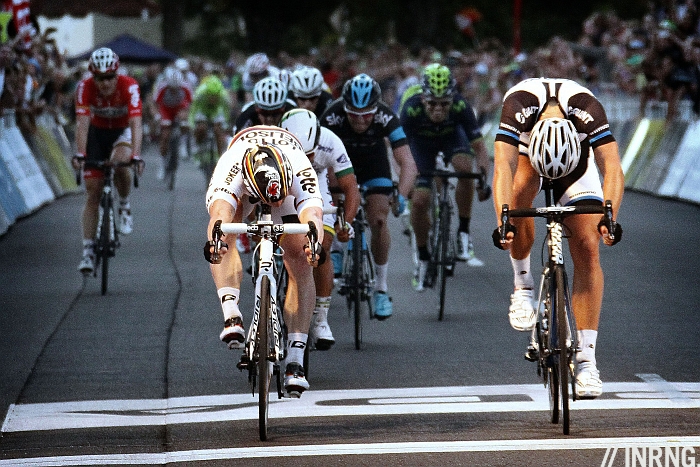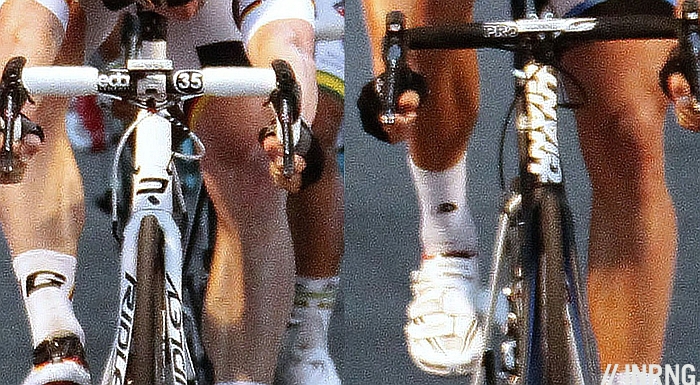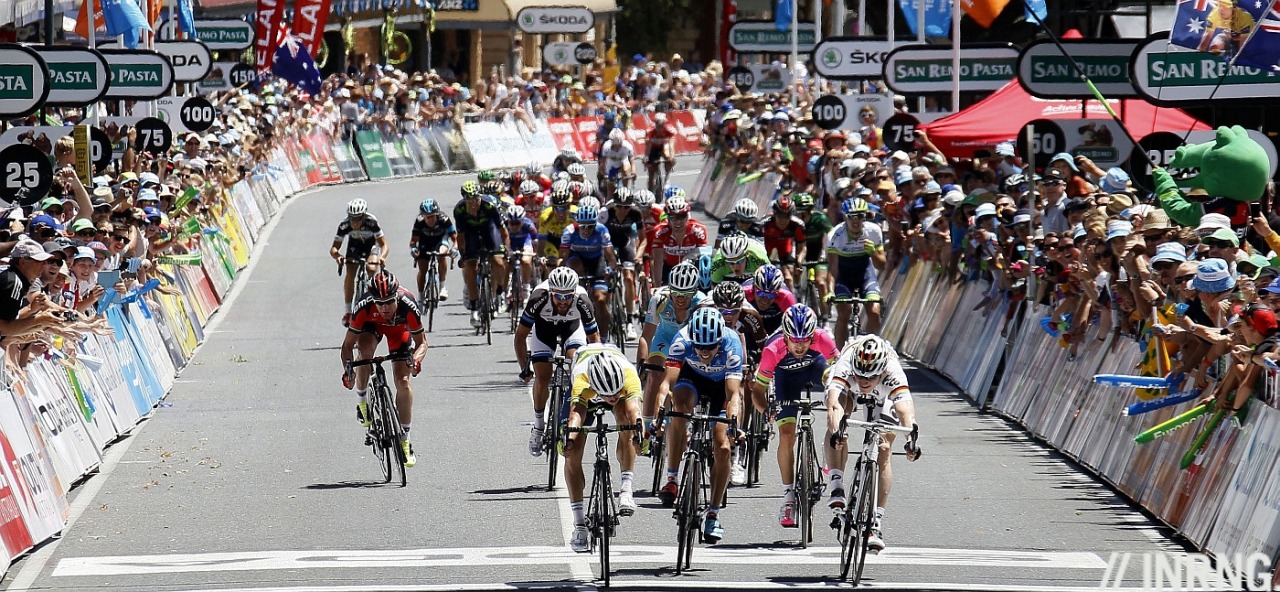André Greipel was second on the opening stage of the Tour Down Under. Getting beaten by Simon Gerrans was an upset but Greipel’s presence in the front group was a surprise. Or was it? He’s often able to get over a short climb that others cannot. You might remember Greipel’s win in Le Cap d’Agde in the 2012 Tour de France when the bunch went over a steep climb in the port town of Sète and there are other examples. In fact “The Gorilla” has some mountain heritage, it’s a little known fact but a junior Greipel was German hill climb champion. It was in 2000 in the ski resort of Garmisch-Partenkirchen, high in the Bavarian Alps. He remains a specialist sprinter but don’t confuse his hulk with bulk.
Tom Boonen going nowhere
Now a tale of someone going nowhere. Tom Boonen got stuck in a lift with team mate Stijn Vandenbergh and OPQS team PR Alessandro Tegner. Vandenbergh tried some DIY while Boonen “was quiet at the back” according to Sportwereld.be, the sports website of Het Nieuwsblad. This might sound trivial but this illustrates how Boonen being stuck in a lift makes the news in Belgium, his every move and even the times when he’s immobile are documented. No other country offers such extensive coverage of our sport.
Berhane wins two stage races in same week
 He can climb, he can sprint, he’s young and wears green. Peter Sagan, right? No meet Natnael Berhane, the Eritrean rider on Europcar who’s won the Tropicale Amissa Bongo. Caja Rural’s new signing Luis-Leon Sanchez took the overall lead but could only watch as Berhane powered to take time bonuses in intermediate sprints and stage finishes and managed to claim the overall lead on the final stage. This was in part thanks to help from his friends in the Eritrean national team who, despite having no tactical interest, took part in the intermediate sprints to swamp Sanchez. Berhane’s not well known but it seems everyone has a good word to say about Berhane whether for his talents or his manners. His contract’s up at the end of the year and we’ll see what else he can deliver during the year. As a bonus it seems he’s now officially the winner of the 2012 Tour of Turkey after Turkish cycling finally condemned Mustafa Sayar. As ever it’s a poor way to win a race, no celebrations or joy but he does bag some points.
He can climb, he can sprint, he’s young and wears green. Peter Sagan, right? No meet Natnael Berhane, the Eritrean rider on Europcar who’s won the Tropicale Amissa Bongo. Caja Rural’s new signing Luis-Leon Sanchez took the overall lead but could only watch as Berhane powered to take time bonuses in intermediate sprints and stage finishes and managed to claim the overall lead on the final stage. This was in part thanks to help from his friends in the Eritrean national team who, despite having no tactical interest, took part in the intermediate sprints to swamp Sanchez. Berhane’s not well known but it seems everyone has a good word to say about Berhane whether for his talents or his manners. His contract’s up at the end of the year and we’ll see what else he can deliver during the year. As a bonus it seems he’s now officially the winner of the 2012 Tour of Turkey after Turkish cycling finally condemned Mustafa Sayar. As ever it’s a poor way to win a race, no celebrations or joy but he does bag some points.
Tour de Phil
 One rider who got to experience the full joy of winning was Phil Gaimon. His wins his first race with Garmin-Sharp. Strictly-speaking he’s not a neo pro as he’s 26 and he’s done plenty of big races before. But he’s stepped up from the UCI Continental ranks to the fully professional ranks. We have to back to 2011 when Andrea Guardini’s win in the Tour de Langkawi and FDJ’s Geoffrey Soupe’s win in the Tropicale Amissa Bongo for a neo-pro winning their first pro race, these two cases just days apart. This step up has often been problematic for riders raised on a diet of US races with their relative short distances and wide roads. But you can prepare for the distance and in an article for Velonews, Gaimon detailed his training:
One rider who got to experience the full joy of winning was Phil Gaimon. His wins his first race with Garmin-Sharp. Strictly-speaking he’s not a neo pro as he’s 26 and he’s done plenty of big races before. But he’s stepped up from the UCI Continental ranks to the fully professional ranks. We have to back to 2011 when Andrea Guardini’s win in the Tour de Langkawi and FDJ’s Geoffrey Soupe’s win in the Tropicale Amissa Bongo for a neo-pro winning their first pro race, these two cases just days apart. This step up has often been problematic for riders raised on a diet of US races with their relative short distances and wide roads. But you can prepare for the distance and in an article for Velonews, Gaimon detailed his training:
The assignment was to ride 4-6 hours a day for three weeks, with as much time around 350 watts as I could handle
Short of working as a bike messenger in Manhattan you can’t prepare too much for the Euro experience of finding yourself in a peloton of 200 riders heading for a farm track and the fight involved for place.
Open for business
Forest fires had threatened the TDU Stage 1 but the race was an opportunity to show the Barossa Valley is open and ready to welcome people. The Tour Down Under is only the latest example of this, see the Tour de France last summer which visited flood-damaged parts of the Pyrenees and arguably many races exist to promote a region. Simon Gerrans is obviously delighted the roads behind Adelaide were open but he spends most of the year in Monaco where several nearby roads are closed after flashfloods provoked landslides and the Col de la Madone is one road amongst others that has been closed.
Built-in brakes
 André Greipel rides a Ridley with Campagnolo and Marcel Kittel has a Giant with Shimano. Greipel looks to be using the narrow 38cm bars again. But what have these bikes got in common? No prizes to the reader who says “wheels” but instead each bike uses internal braking systems.
André Greipel rides a Ridley with Campagnolo and Marcel Kittel has a Giant with Shimano. Greipel looks to be using the narrow 38cm bars again. But what have these bikes got in common? No prizes to the reader who says “wheels” but instead each bike uses internal braking systems.
 For a better close-up, scroll to the end of cyclingtip’s excellent review of all the 2014 team bikes and click on the Giant photos. Rather than the Campagnolo or Shimano model bolted on to the frame or fork, the brake is partially built-in and more so with the Ridley model. I don’t know what the performance is like but this is surely the way of the future. It allows improved aerodynamics and some might like the looks but the best advantage is how the calliper can be built into the frame with the possibility of a stronger structural support meaning even better braking or a lighter unit. It’s one example of a component becoming integrated and we’ll surely get more in time, for example both Kittel and Greipel have electronic gears but for now the CPU device is fixed with to the frame with zip ties when it could easily be stored inside the bars or stem.
For a better close-up, scroll to the end of cyclingtip’s excellent review of all the 2014 team bikes and click on the Giant photos. Rather than the Campagnolo or Shimano model bolted on to the frame or fork, the brake is partially built-in and more so with the Ridley model. I don’t know what the performance is like but this is surely the way of the future. It allows improved aerodynamics and some might like the looks but the best advantage is how the calliper can be built into the frame with the possibility of a stronger structural support meaning even better braking or a lighter unit. It’s one example of a component becoming integrated and we’ll surely get more in time, for example both Kittel and Greipel have electronic gears but for now the CPU device is fixed with to the frame with zip ties when it could easily be stored inside the bars or stem.


I was wondering if Tuesday shorts would be brown as well. 😉
Not sure about the “Greipel was a junior hill climb champion” is still a little known fact. I heard it mentioned on the TdF coverage last year everytime there was a bump near the end of a sprint stage. It’s possibly the most widely known fact about him at this stage!
Which channel were you watching on? I dug up this up a while ago and it always seems to surprise but good if others have found the same.
Eurosport UK. You have me questioning myself now – it might be that I’ve read it multiple times here, but I’m pretty sure I’ve heard Carlton repeat the fact many times.
well, you’ve mentioned it at least 3 times on this blog; it’s almost an inevitability when the subject of a Greipel comes up. Not complaining, but it’s amusing how much this fact tickles you.
It’s just a surprise for others but point-taken, the fact will only get dusted off for special days.
I was pleasantly surprised! Just saying!
I believe you mean the 2013 tour of turkey.
Chris Boardman was the British hill climb champion for four years running from 1988 to 1991.
I thought the same thing, it’s the widest known ‘little known fact’ about any rider. I think it’s still worth pointing out though, because it is quite unusual.
I was completely made up for Berhane winning Amissa Bongo. As you say, nothing can make up for being cheated out of the joy of standing on that top step at the Tour of Turkey.
Well apart from being busted for EPO which several winners have been…what a farce that race has been. Seriously if you’re wondering about the TDU and TdSL where do rank a ‘Turkey’ win? I’ve got plastic toys from a Christmas cracker I’d value more than the GC there.
Speaking of bad websites, you should see the official Presidential Tour of Turkey website.
Interesting point about integrated brakes offering the “possibility of a stronger structural support meaning even better braking”. As spotted by Cycling Tips, Giant Shimano are actually using aftermarket brake arms from Fourier due to the factory-issue TRP ones not offering adequate braking. Belkin did the same last year on their Propels. One thing is for sure, it is a great way to differentiate one’s bikes from the competition and is a very obvious aerodynamic feature compared with tube profiles; however, at this time it would seem there is still work to be done on refining the concept.
As for Greipel’s hill climbing history, the Inner Ring was the first place I ever heard of it. It is certainly interesting that is now mentioned so often by mainstream commentators.
re the “integrated” mini-V-brake used on the Giant Propel :
I took a Propel test ride recently and the mushiness/softness of the integrated TRP caliper was a bit disconcerting. Definitely did not feel as crisp & firm as a high quality dual-pivot caliper. The TRP calipers use carbon-fiber arms, may be part of the problem.
Hopefully the aftermarket Fourier calipers, made of aluminum, will feel stiffer.
Also, the stock Propel TRP brakes are a pain to switch between different rim width, requiring shims behind the brake pad blocks. Whereas, the “noodle” on the Fourier calipers has 2 positions, allowing a quick setup change between rim widths.
For a conusmer, annoying to have to spend another US$300 on aftermarket Fourier calipers, and the original TRP calipers willl have virtually no resale value.
You really hate those junction box zip ties Inner Ring. I do too. Beyond comprehension for the worlds great aesthetes, the Japanese, and on their flagship group set too. Crying out for integration.
They just seem an anomaly on a $10,000 bike. I know they are universal and literally flexible but still, why not hide things. Even the basic fork speed sensor could be housed inside the fork with the battery housed just under the stem cap etc.
As you have said on your blog before, there is no excuse for all of the electric wiring and hardware not to be internal within the frame/bars. All that should be showing is a port for charging (that could be covered by a rubber cap – like many digital SLR cameras) and perhaps a port or two for connectivity between components. I presume getting a cable past the head tube and steerer tube internally poses the biggest issue for total integration with currently designed frames.
I have had Di2 since it was released. No way I was going to use the standard junction box with zip ties, so I used the Shimano Di2 Flight Deck computer that had limited release at the time.
Still going strong 3 years later. It incorporates all the usual things plus battery charge indicator and rear derailleur adjustment.
There is a bit of footage that someone has uploaded to Youtube:
https://www.youtube.com/watch?v=FzpLVP4KhDI
380mm bars I think….
Quite ride, cm and not mm.
The Greipel Junior Hill Climb Champion thing is definitely your favourite fact!
Re: internal junction boxes
I spend a good amount of time around Di2 equipped bikes, some, like the Cervelo P5 with internally mounted CPUs. It is actually quite difficult to get a junction box into a frame, and not just from a technicians view. To connect wiring to both ends of the unit, considerable access to the interior of the frame/stem/bars is required. For example, the P5 has a removable panel on the integrated stem for the CPU to reside.
I agree but that’s as things stand now. What if we had proper integration where the unit was built into the stem or some other component first? Better still it will all go wireless so the shifters activate the gears without a cable.
The problem with wireless is that every component needs its own battery, plus a high level of security to ensure no interference from other bikes or RF equipment like mobile phones. This adds bulk to the system, and in my view is totally unnecessary as you don’t need to move your electronic groupset once it’s installed. In fact, I’d rather see a more integrated electronic system developed that includes lights, computer, powermeter, groupset, and even your Go-Pro powered from a single battery. You can then easily add or remove these components as you need while keeping the overall weight down. This is very do-able, it just needs a few industry heavyweights to collaborate on standards.
Those brakes look similar to the ones I have on my hybrid, complete with the ‘sausage’ (metal cable housing), although mine is in front of the fork. They are called V-brakes I think.
Looks to me like another example of MTB influence.
The bike makers keep adding new reasons for me NOT to buy a new bike. Throwing away perfectly good Campagnolo brake calipers for some flimsy, flexy OEM brakes could be reason #1. And didn’t Trek recall a model of theirs with some sort of integrated front brake recently? Bicycles, even with multiple gears and sprockets, used to be fundamentally simple machines. Making them more complicated, with ever more proprietary componentry and battery-operated stuff may do wonders for the bottom line of those who make them, but they leave me cold, kind of like admiring a vintage airplane versus a modern fighter plane, especially when I consider the stealthy things that can only fly due to powerful, onboard computers.
Brakes are for losers 😉
WiFi shifting: I can see the hackers getting ready for the up shifts on Mtn top finishes.
Agree it is pitiful to zip tie crap on a $10,000 bike like it’s an experiment.
I still love the thought of a p*ssed off DS being able to jam a rider into the big ring at an inappropriate moment!
With regard to brakes, a fork without a caliper sat on the front looks just plain odd to me. But I am not bothered about saving a nano of a watt that the marketers think I am.
Good stuff from Berhane.
I became aware of him from the Tour of Turkey Stage 3 (http://www.youtube.com/watch?v=Fpi5lnE6-uw).
A great vid for both Berhane’s face (and sprint) as he pulls the lead group up the final climb and the commentators none-too-subtle hints about Sayar doping (i.e. comparing him to Vandenbrouke and saying his performance is “definitely a bit special”!)
Any ideas what races Berhane is looking at this season? Be interested to see how he gets on.
I’d guess that caliper integration will become irrelevant if/when discs are approved by the UCI. But that’s another debate.